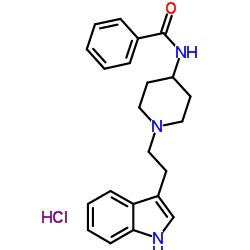CHEMICAL IDENTIFICATION
-
RTECS NUMBER :
-
CV5396000
-
CHEMICAL NAME :
-
Benzamide, N-(1-(2-(1H-indol-3-yl)ethyl)-4-piperidinyl)-, monohydrochloride
-
CAS REGISTRY NUMBER :
-
38821-52-2
-
LAST UPDATED :
-
199707
-
DATA ITEMS CITED :
-
5
-
MOLECULAR FORMULA :
-
C22-H25-N3-O.Cl-H
-
MOLECULAR WEIGHT :
-
383.96
HEALTH HAZARD DATA
ACUTE TOXICITY DATA
-
TYPE OF TEST :
-
TDLo - Lowest published toxic dose
-
ROUTE OF EXPOSURE :
-
Oral
-
SPECIES OBSERVED :
-
Human - woman
-
DOSE/DURATION :
-
7 mg/kg/1W-I
-
TOXIC EFFECTS :
-
Behavioral - wakefulness Behavioral - excitement Cardiac - pulse rate increase, without fall in BP
-
REFERENCE :
-
PRACAK Practitioner. (Morgan-Grampian Ltd., 40 Beresford St., Woolwich, London SE18 6BQ, UK) V.1- 1868- Volume(issue)/page/year: 228,362,1984
-
TYPE OF TEST :
-
LD50 - Lethal dose, 50 percent kill
-
ROUTE OF EXPOSURE :
-
Oral
-
SPECIES OBSERVED :
-
Rodent - rat
-
DOSE/DURATION :
-
1800 mg/kg
-
TOXIC EFFECTS :
-
Details of toxic effects not reported other than lethal dose value
-
REFERENCE :
-
43NDAD "Pharmacology of Antihypertensive Drugs," Scriabine, A., ed., New York, Raven Press, 1980 Volume(issue)/page/year: -,161,1980
-
TYPE OF TEST :
-
LD50 - Lethal dose, 50 percent kill
-
ROUTE OF EXPOSURE :
-
Intraperitoneal
-
SPECIES OBSERVED :
-
Rodent - rat
-
DOSE/DURATION :
-
500 mg/kg
-
TOXIC EFFECTS :
-
Details of toxic effects not reported other than lethal dose value
-
REFERENCE :
-
43NDAD "Pharmacology of Antihypertensive Drugs," Scriabine, A., ed., New York, Raven Press, 1980 Volume(issue)/page/year: -,161,1980
-
TYPE OF TEST :
-
LD50 - Lethal dose, 50 percent kill
-
ROUTE OF EXPOSURE :
-
Oral
-
SPECIES OBSERVED :
-
Rodent - mouse
-
DOSE/DURATION :
-
1 gm/kg
-
TOXIC EFFECTS :
-
Details of toxic effects not reported other than lethal dose value
-
REFERENCE :
-
43NDAD "Pharmacology of Antihypertensive Drugs," Scriabine, A., ed., New York, Raven Press, 1980 Volume(issue)/page/year: -,161,1980
-
TYPE OF TEST :
-
LD50 - Lethal dose, 50 percent kill
-
ROUTE OF EXPOSURE :
-
Intraperitoneal
-
SPECIES OBSERVED :
-
Rodent - mouse
-
DOSE/DURATION :
-
450 mg/kg
-
TOXIC EFFECTS :
-
Details of toxic effects not reported other than lethal dose value
-
REFERENCE :
-
43NDAD "Pharmacology of Antihypertensive Drugs," Scriabine, A., ed., New York, Raven Press, 1980 Volume(issue)/page/year: -,161,1980
|

